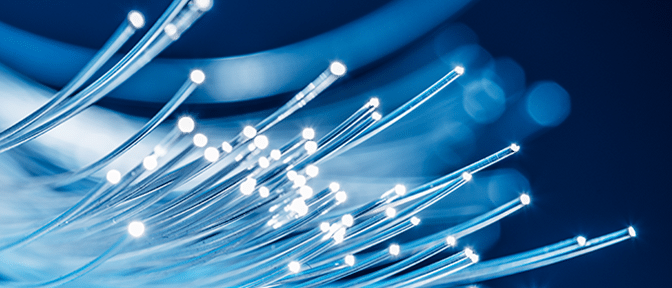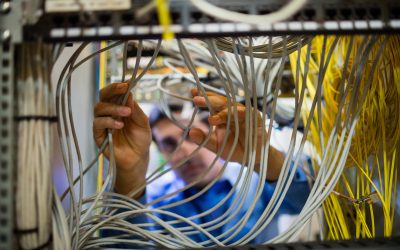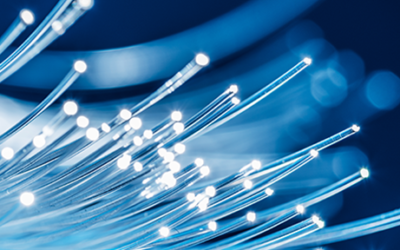Understanding the Bits that Hertz

Tags: cabling | coding | fiber optic | Wireless
Megabits versus Megahertz
Often, confusion can arise when talking about and specifying wired or wireless system bandwidth and other performance requirements for current and future high speed data applications. The confusion relates to the terms ‘Megabits per second’ (Mbps) and ‘MegaHertz’ (MHz), or ‘Gigabits per second’ (Gbps) and ‘GigaHertz’ (GHz). Mbps and MHz are NOT the same thing although their numerical values may in some instances coincide. Transmission properties such as loss, crosstalk and bandwidth are typically specified as a function of Hertz (Hz), or cycles per second. Digital data is transmitted as a series of ‘0’s and ‘1’s, called bits. The speed at which these digital symbols are transmitted is measured in bits per second.
Simply put, 1000 Mbps (Gigabit Ethernet) does not mean the system is operating at 1000 MHz or 1GHz, and therefore the actual requirements for the wired or wireless channel relies on an understanding of the relationship between the bit rate and the frequency. This relationship is founded on what is known as bandwidth-efficient digital communication that is based on technology and science that has been around for decades.
The purpose of this article is to provide an introduction to bandwidth-efficient digital communication, and enable the reader to better understand how high speed data protocols are transmitted. It cannot promise to detail the complete picture, but rather a basis for further understanding of how data is transmitted and received and how cabling performance can impact this. In simple terms, there are three ways of transmitting higher bit rates over cabling, one is to improve the cabling performance, the second is to improve the technology in the electronics, and thirdly and more commonly is a requirement for a mixture of both.
Coding Schemes
Bandwidth-efficient line codes can be used to provide higher bit rates in a given bandwidth, or, alternatively, they can also be used to reduce the required bandwidth for a fixed bit rate. Examples of the first type of uses of this technology were voiceband modems and digital radio. The first bandwidth efficient data transmission schemes were developed about fifty years ago for voiceband modem applications. Since then, the voiceband modem designers have always been at the forefront of the search for improved bandwidth efficiency. This is mostly due to the low bit rates and small channel bandwidth (< 4kHz) that are involved in this application, which drove an early usage of advances in technology, such as digital signal processing.
The main focus here will be on the application of the technology to local networks, with the ultimate goal of showing how high bit rates can be provided reliably over cabling in a lower or limited bandwidth. Looking at applications such as 1 and 10 Gigabit Ethernet and potentially beyond, understanding the impact of coding and other techniques is vital to fully realize the potential of a particular grade of cabling system.
Throughout this article, bandwidth-efficiency will be defined as the ratio between the bit rate and the effective bandwidth utilization of a transceiver or line code scheme. Increasingly higher date rates require an increasing amount of bandwidth-efficiency because of the band-limited nature of the available channels. Bandwidth-efficiency comprises a product of two components – two completely different and independent techniques, which are multilevel encoding and efficient spectral shaping.
With multilevel encoding, the pulses that are sent through the communication channel carry enough information to represent blocks of bits rather than one single bit, as is done with most of the first LAN line codes such as Ethernet. For a given bit rate, the usage of multilevel-encoded pulses results in a decrease of the rate (often referred to as the Baud rate) at which the pulses have to be sent through the channel, which, in turn, decreases the bandwidth requirement for the transmission channel.
With efficient spectral shaping, the square-shaped pulses that are used with LAN line codes are smoothed out in time to eliminate any sharp voltage transitions. As a result, fewer high frequency components are generated by the pulses, which also decreases the bandwidth requirement for the channel. Designers have improved the bandwidth-efficiency of their transceivers, over the years, by making steady incremental progress on both the multilevel encoding and spectral shaping fronts.
Before we move on to discuss some of the common line codes, let’s make a few points to help with the discussion. The first point is that the transmitter of most line codes can, conceptually, be considered as the cascade of an encoder and a shaping filter, and a filter and decoder for the receiver, even though this may not be the way these lines codes are implemented in practice. The second point is that the bandwidth-efficiency of line codes can be improved by using better encoders and better shaping filter.
Thirdly, for definition, the bit rate is the number of bits transmitted in one second. The symbol or baud rate refers to the number of signal units, or symbols, per second that are required to represent those bits. Bit rate equals the symbol/baud rate times the number of bits represented by each signal unit. Bit rate is always greater than or equal to the symbol/baud rate.
NRZ Line Code (Non Return to Zero)
For the NRZ line code a logical zero (0) is transmitted as a negative voltage and a logical one (1) is transmitted as a positive voltage (or vice versa). Let’s assume the bit rate is R, expressed in bits per second (bps). As stated, conceptually, the transmitter can be considered as the cascade of an encoder and shaping filter. The encoder maps the incoming bits 0 and 1 into impulses or ‘symbols’ equal to +1 and –1, respectively. The symbols generated are fed to a shaping filter, which has an impulse response with duration T. In the case of NRZ, the pulse width T is also equal to the time interval between successive symbols. This time interval is called the symbol period. The inverse 1/T of the symbol period is equal to the symbol or baud rate, expressed in bauds. For NRZ therefore, the symbols rate is equal to the bit rate.
The theoretical power spectrum of the signal that is generated by the NRZ transmitter has it’s first null at frequency f =1/T, which is the symbol rate. It is generally assumed that the frequency components above this first null can be neglected, so that the effective bandwidth utilization B of the NRZ line code is B=1/T, which is also this line codes bit rate R. Since R bps are transmitted in a bandwidth of B = R Hz, we can conclude that the bandwidth-efficiency R/B of the NRZ line code is equal to one bit per second per hertz of bandwidth.
The NRZ line code can be considered a variant of what is known as the more general two level Pulse Amplitude Modulation (PAM-2) line code.
Bandwidth Efficient line codes
Bandwidth-efficient lines codes, as one might guess, are those that offer better bandwidth-efficiency than that of the NRZ line code (being one of the simplest). As discussed earlier, there are two main ways of improving the bandwidth-efficiency of the signal generated by the transmitter. One way is to change the characteristics of the shaping filter. A more powerful way of improving the bandwidth-efficiency is to replace the binary encoder with a so-called multilevel encoder. With such an approach, the bandwidth-efficiency can be improved dramatically depending upon the number of levels. However the more levels used the more susceptible to system is to noise, which therefore requires closer understanding and definition of the transmission channel (cabling) to cater for this and/or compensation techniques are employed to overcome this such as NEXT cancellation etc.
Spectral shaping
It is possible to improve a line code’s bandwidth-efficiency by using better shaping filters. With present knowledge, an upper bound of the improvement in bandwidth-efficiency through improvement in the characteristics of the shaping filter for truly band limited data signals is a factor of two. This is known as Nyquist Theorem. According to the Nyquist Theorem, to ensure the accurate reproduction of an original analog signal using PAM, the sampling rate must be at least twice the highest frequency of the original signal. Applying this in the context of data rate and bandwidth, it means that a signal of bit rate R may still be recovered from a minimum bandwidth of R/2. Therefore a Nyquist shaping filter will provide the optimum improvement in bandwidth-efficiency through spectral shaping, and this is a doubling of the bandwidth-efficiency of the system. In practice, shaping filters are generally implemented with less than this optimum bandwidth-efficiency to balance available bandwidth, performance, complexity and implementation cost.
Multilevel Encoding
Multilevel encoding is an encoding procedure where blocks of N bits are mapped into symbols that can assume more than two values or levels. In general, the encoding of blocks of N bits requires the usage of 2N different symbol values (also known as levels in the case of PAM coding schemes) and reduces the symbol rate and bandwidth requirements by a factor of N (for a fixed bit rate). Thus if 1/T and B are the symbol rate and bandwidth required for a given line code using binary (2-level) encoding, then the usage of multilevel encoding reduces these requirements to 1/NT and B/N respectively.
The preceding sections have discussed two major techniques used to improve the bandwidth-efficiency of line codes, namely multilevel encoding and efficient spectral shaping. Putting these two together results in an equation that can be used as a quick guide to the minimum bandwidth required to transmit a certain bit rate.
R = 2*B*N bps, or alternatively, B = R/(2*N) Hz
Where N = log2(M) and M is the number of levels/symbols
This is known as Nyquist Theorem.

Written by James Donovan
You might also enjoy
FO Connector Contamination – A Constant Threat
Fiber optic communication most commonly works in duplex or multifiber transmission by transmitting light to a receiver in one direction on a fiber and receiving transmitted light back to a second receiver on the second fiber. Most engineers can understand that and...
Why Inspect and Clean Fiber Optic Connectors?
Inspecting and cleaning of fiber optic connectors during installation and when making any patching, is essential. Any contamination on a patch cord connector will be transferred through the coupler to the connector it is mated to. Even when testing fibers with a test...
Cleaning MPOs
MPO connectors should always be inspected with a scope before they are used, be that on a patch cord or a bulkhead. If they need to be cleaned, one-click cleaners are keyed to ensure the tip only fits one way onto the connectors and is able to clean both male and...


